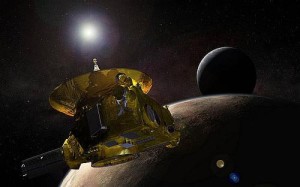
We have all heard about NASA’s New Horizon’s mission to Pluto and beyond recently this summer. The launch of this spacecraft was incredibly on January 19, 2006. That’s over 9.6 years ago! Pluto was a prime target to examine but the ship will continue into the Kuiper Belt, a disc-shaped region of icy bodies of which Pluto is a part. New Horizons, a piano-sized probe (See the figure below) weighing 478 kg, is the only mission to explore the Kuiper belt so far.

The Kuiper Belt and the Oort Cloud surround our sun, a star. The Kuiper Belt is a doughnut-shaped ring, extending just beyond the orbit of Neptune from about 30 to 55 AU (An Astronomical Unit or AU is the average distance between Earth and the Sun, which is about 93 million miles or 150 million kilometers. Astronomical units are usually used to measure distances within our Solar System.). The Oort Cloud is a spherical shell, occupying space at a distance between five thousand and 100 thousand AU.
Now let’s get into our favorite part of the article—the electronics. I want to use the New Horizons spacecraft and its voyage to Pluto as an excellent example of the challenges to electronic systems on a long journey in space. My research has delved into the system designs and functionality as well as some of the difficulties an engineer would face in designing such systems.
Story Source:
The above post is reprinted from materials provided by eetimes. Note: Materials may be edited for content and length.












0 responses on "NASA Deep-Space mission challenges: Antennas to MIPS"